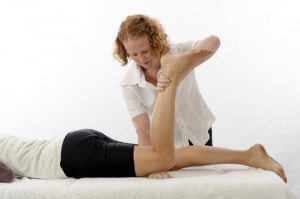Non-Pharmacological Treatment
Manual Therapy

Manual therapy is a global term for mobilisation and manipulation of joints. It is delivered by chiropractors, osteopaths and physiotherapists who have acquired a postgraduate training qualification. Although many physiotherapists claim to perform manual therapy, they are unqualified in performing the skill of manipulation without a postgraduate qualification.
There is no meta-analysis for the efficacy of manual therapy in patients with hip OA. A study by Hoeksmaet al (2004) compared an individually tailored exercise programme to a standard protocol manual therapy programme. Both arms showed a reduction in pain and improvement in physical function with manual therapy superior to exercise.
There is no meta- analysis reported for the efficacy of manual therapy in patient with knee OA. Many of the RCT’s are small <50 or used with other modalities. Deyleet al (2005) compared manual therapy in combination with supervised exercise and home exercise programme to home exercise alone for the knee. Both pain relief and function were superior in the active group relative to the control. With an NNT of 6 for both domains this is again an area which requires further exploration
NICE (2008) concluded that manipulation and stretching should be used as an adjunct to exercise, however with small effect size for pain and no evidence for a change in physical function for exercise, manual therapy may prove to be the treatment of choice, especially for hip pain compared to exercise alone; the NNTs certainly indicate that further research is warranted.
Braces
Braces and orthoses (shoe insoles) are defined as ‘any medical device added to a person’s body to support, align, position, immobilize, prevent or correct deformity, assist weak muscles, or improve function’ (Deshaies 2002). Braces are mainly prescribed to modify the mechanical stress placed on the symptomatic joint compartment by correcting joint instability and alignment. For knee osteoarthritis these are external devices mainly of two types; knee sleeves and unloading knee braces.
Knee sleeves are elastic, non-adhesive orthoses aimed at patellar alignment or frontal femoro-tibial stabilization. Patellar mal-alignment is associated with patellofemoral knee osteoarthritis and the progression of the joint-space narrowing depends on the medial or lateral patella displacement.
Unlike knee sleeves, unloading braces are functional devices. Composed of external stems, hinges and straps, they aim to decrease compressive loads transmitted to the joint surfaces, in the medial or lateral femoro-tibal compartment depending on the valgus or varus position of the device.
A review by Brouwer et al (2008) cited two randomised clinical trial (comparing patients with knee sleeves with medical treatment or valgus braces with medical treatment and a control group without knee sleeves or braces. Both these studies demonstrated a small reduction in pain and increase in function.
Orthoses
Like knee bracing, orthoses are designed to unload the diseased compartment. Maillefertet al (2001) compared laterally and neutrally wedged insoles for medial compartment knee OA and actually showed less improvement in pain scores and physical function than neutrally wedged insoles Rodrigues (2008) examined medial wedged insoles for patients with lateral compartment knee OA compared with neutrally wedged insoles. Although a small study (n=30) which could undermine its validity, the relative effect on pain on movement scores and improvement in function were 2.07 and 3.19 respectively. It is surprising that a larger study to replicate these findings has not been performed to date.
Electrotherapy
Electrotherapy and electrophysical agents include pulsed short wave diathermy (pulsed electromagneticfield, PEMF), interferential therapy, laser, transcutaneous electrical nerve stimulation (TENS) and ultrasound. All are commonly used to treat the signs and symptoms of OA such as pain, trigger point tenderness and swelling (NICE 2008). NICE (2008) concluded that studies using these modalities had varying methodological quality and detail on treatment dosages. Ultrasound appeared to provide no benefits beyond placebo ultrasound or other electrotherapy agents inthe treatment of knee and hip osteoarthritis (Robinson et al. 2001). There was no evidence for the benefit of LASER for pain relief at mixed sites of osteoarthritis from a systematic review (Brosseauet al. 2000), however, Yurtkuran et al (2007) found a benefit of LASER at acupuncture points in reducing knee swelling. Use of pulsed electromagnetic field for osteoarthritis was limited in knee osteoarthritis (McCarthy et al. 2006). No hip studies were identified. There is insufficient evidence to support the use of ultrasound, LASER and pulsed electromagnetic field in osteoarthritis in hip or knee OA. There is evidence that TENS is clinically beneficial for pain relief and reduction of stiffness in knee osteoarthritis, especially in the short term.
Acupuncture

Acupuncture involves treatment with needles, and is most commonly used for pain relief. Typically, about six needles are placed near the painful area and possibly elsewhere. They will be either manipulated to produce a particular ‘needle sensation’, or stimulated electrically (electroacupuncture) for up to 20 minutes. Some practitioners also use moxa, a dried herb which is burned near the point to provide heat. A course of treatment usually consists of six or more sessions during which time, if a response occurs, pain is gradually relieved; the response of individuals, however, is variable. NICE (2008) concluded that the results from acupuncture studies are mixed. Therefore, NICE (2008) proposed that there is not enough consistent evidence of clinical or cost-effectiveness to allow a firm recommendation on the use of acupuncture for the treatment of osteoarthritis.

